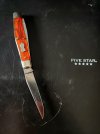AlOx or SiC sandpaper can be extremely aggressive on some steels, which can be a good or bad thing, depending on what you're trying to do. SiC sandpaper in particular can generate some heavy burrs on low-alloy stainless steels at low or moderate hardness (mid-high 50s HRC).
It is possible to create a very wide, but also very thin & fragile burr that'll wipe away with most any contact. So, what you saw might've been a burr, but a very thin & fragile one. When I was using a guided system years ago, I wasn't yet familiar with the concept of the burr. I sharpened way beyond the initial creation of the burr, and didn't notice anything unusual until I lightly dragged my fingertip across the edge and saw a sliver of metal break off onto my fingertip. I thought something was wrong with the steel - but then the lightbulb clicked 'ON' in my head and I realized I was looking at the remains of a very wide and thin burr that'd broken off. Epiphany moment there, and a good lesson learned.

